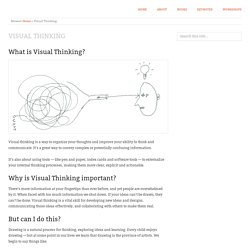

Sketcho Frenzy: The Basics of Visual Note-taking. Why Use Sketchnotes in the Classroom? Back in April, I was invited to give a workshop on sketchnotes in the classroom at Indiana University by IU’s Center for Innovative Teaching and Learning.

Blog readers may recall that I posted a short lit review of the research on student notetaking back in February. That was part of my prep work for this sketchnotes workshop. I really wanted to blog about the workshop shortly after it occurred, but between wrapping up the Vanderbilt Center for Teaching’s “Students as Producers” theme year and preparing for the CIRTL Network MOOC scheduled to launch this fall, time for blogging has been scarce.
(In fact, this is my first post since April, when I blogged about the Coursera Partners Conference in London.) Better late than never, I wanted to share here on the blog the Prezi I used for the workshop, along with a few annotations and reflections on the workshop, mainly focusing on reasons why sketchnotes might have a place in the classroom. First, the Prezi itself: See? References. How Royan Teaches Sketchnoting. Visual Thinking. What is Visual Thinking?

Visual thinking is a way to organize your thoughts and improve your ability to think and communicate. It’s a great way to convey complex or potentially confusing information. It’s also about using tools — like pen and paper, index cards and software tools — to externalize your internal thinking processes, making them more clear, explicit and actionable. Why is Visual Thinking important? There’s more information at your fingertips than ever before, and yet people are overwhelmed by it.
But can I do this? Drawing is a natural process for thinking, exploring ideas and learning. “I’m no artist” “I can’t draw a straight line” “I can’t draw a stick figure” This is a fallacy. Brain Doodles. Sketchnoting. Sketchnotes 101: Visual Thinking. Sketchnotes by Craighton Berman.

The recent rise of the "visual thinking" movement in business borrows from the natural ways designers work—using sketches to explore and express ideas, manipulating complex systems of thoughts on sticky notes, and using rough visuals to make sense of the world. Humans are, of course, wired to be visual thinkers from birth, so it's only natural that people are attracted to these tools, and the power they have to help solve problems and explore opportunities. In the long list of tools one could use for visual thinking, sketchnotes are one of the most exciting. Simply put, sketchnotes are visual notes that are drawn in real time. Through the use of images, text, and diagrams, these notes take advantage of the "visual thinker" mind's penchant for make sense of—and understanding—information with pictures. Sketchnote by Eva Lotta Lam Sketchnoters aren't reporters, information designers, or illustrators.
Sketchnote by Mike Rhode Next up: How to sketchnote. Sketchnote Resources for Teachers. Sketchnotes are a creative way to create understanding of new concepts.

It can be used in any content area. Implementing them in your classroom is a great strategy to increase student engagement. Overview of Sketchnotes This is a great introductory video to share with students before you implement the process of sketchnotes. Rather than taking notes in the traditional outline format. Sketchnote Resources: Websites Agile Learning This blog post has extensive information about the science behind sketchnoting and why it is an effective tool in the classroom. TBD Teacher On her Tumblr blog this teacher from Colorado shares the application of sketchnotes as she experienced it in her classroom.
Being Ms. This is another site where the teacher shares her experiences with the use of sketchnoting in her classroom. 10 Tips to Get Started with Sketchnoting Workshop. I facilitated a workshop at Miami Device this past week.

Most conference sessions feel rushed with only 45-60 minutes to share, but thanks to Felix Jacomino‘s the genius mind behind the conference, scheduled my 10 Tips to Get Started with Sketchnoting workshop for 2 hours! It gave us the opportunity to DO what we were talking about. Participants were able to practice sketching the content of the workshop as they were learning about sketchnoting! We walked, step by step, through building a sketch by remembering these 10 tips: Remembering that you don’t have to be an artist to use sketchnoting as note taking or to make your thinking visibleSkethnoting is about ideas, connections, thinking, about the process , visualizing and organizing your thinkingWhat can be sketchnoted?
Enjoy some of the participants’ sketchnotes of the workshops (for some the first attempt) By Jeannette Kostka Sketchnoting another session at Miami Device by Tammy Neill Related. Sketchnoting.